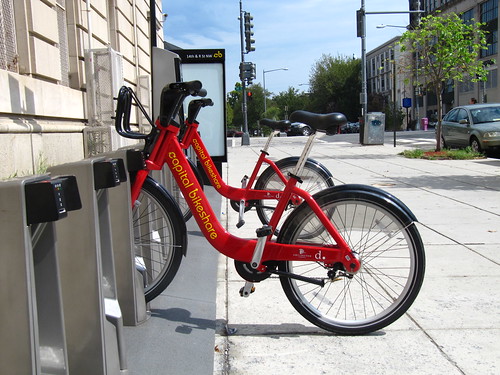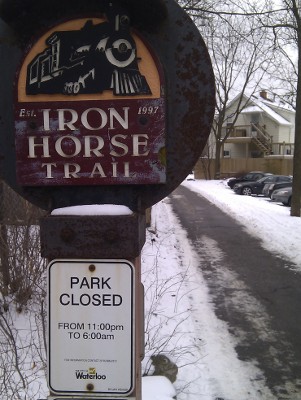
Washington, D.C.'s Capital Bikeshare (Photo: James D. Schwartz / Flickr)
Yesterday was a momentous day for cycling in Ontario — not because of the election, but because Ontario’s first modern bike-sharing system has launched in Toronto. The Toronto BIXI system hopes to replicate the success of Montreal’s original BIXI installation. Waterloo Region should be getting in on bike-sharing too.
Bike-sharing is a way of using bicycles as public transit for short trips. A system of stations is densely distributed across a portion of a city, with secured self-serve access to bicycles on demand at stations. The system is designed not for long-term bike rental, but for bicycles to be taken for trips from a point A to a point B. Near point B, the bike is returned to another station and back into circulation.
It’s a remarkably efficient transportation infrastructure, and is reasonably inexpensive to operate — often made cheaper or even profitable through advertising. The bicycles are sensible upright city bicycles and require no special gear to ride. Like transit, bike-sharing extends the reach of a person on foot but without requiring one to use their own vehicle or the same vehicle for every leg of a series of trips.
One of the best reasons to invest in bike-sharing is that it is an easy way to increase the number of people cycling. Bike-sharing breaks down some of the barriers to cycling in the city, increasing the number of people getting around by both the public bikes and their own bikes. That, in turn, helps to bootstrap support for putting in place high-quality cycling infrastructure on city streets.
Last fall Washington, D.C. launched a bike-sharing system similar to Toronto’s, which has proven very popular and is already expanding. Many cities are now developing bike-sharing systems or looking to start them. Locally, Research in Motion has its own small BIXI system. How about bike-sharing for Waterloo Region?
Several months ago, a group at the University of Waterloo led by Josh Joseph began advocating for a bike-sharing system on campus. Just recently they have shifted their sights to a Region of Waterloo bike-sharing system, which is something we fully support. Check out their website and the impressive support they have received, both from politicians and on a nearly 1000-strong petition.
Even prior to the UW-based initiative, many individuals and organizations have expressed interest in getting a regional bike-sharing system going. During the last municipal elections, one of our questions for Regional Council candidates was specifically about a bike-sharing system for Waterloo Region. You can see their responses here. Most of Regional Council looks to be on board with the idea.
So it’s not a matter of whether to bring bike-sharing to Waterloo Region, but when, where, how big, who’s paying, and how much. Let’s get the Region rolling.
Read More »



